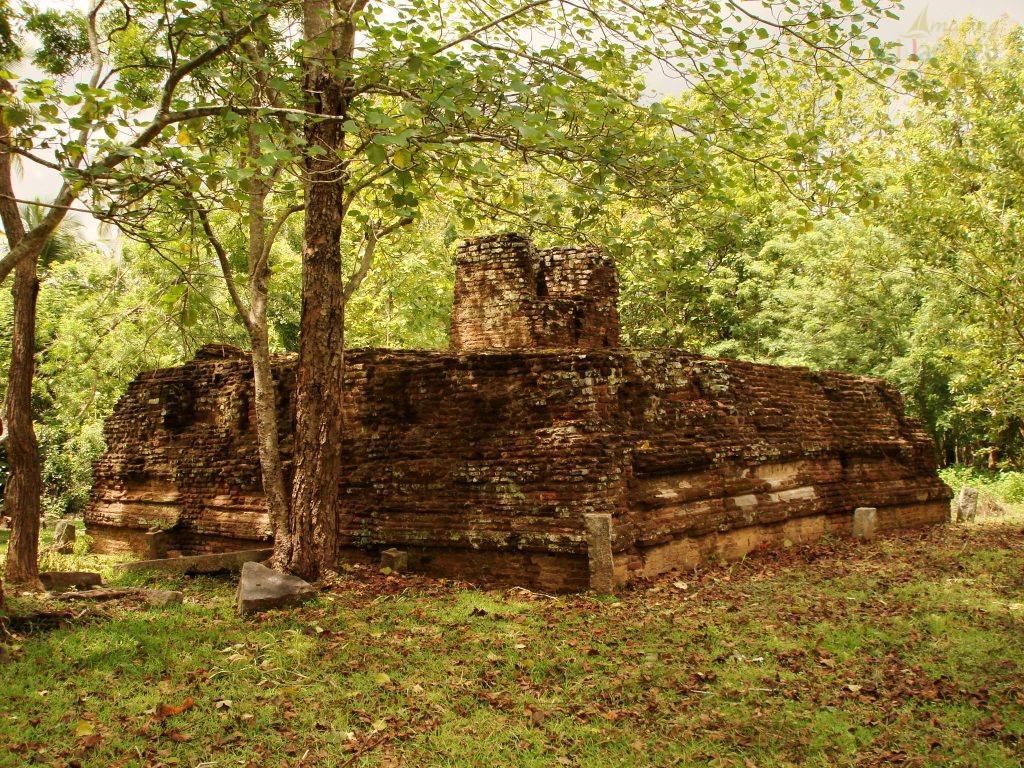Stupas in all Shapes and Sizes

Stupas are no doubt wonderful architectural structures. White washed beaming dome shaped stupas are a common sight in the rural Sri Lankan landscape. Even amidst the urban buzz in cities like Colombo, one can witness small white domes under the blazing sun, still maintaining their pride in the midst of the ultra-urban cityscape. Although almost all the modern stupas of Sri Lanka are small in size, the ancient landscape of the country was decked up by sky-hugging giant stupas which are only compatible with the Egyptian pyramids in their size and technology.
The most common stupas we see today are in the shape of a bubble, heap of paddy, shape of a bell or a pot. Yet, there are more shapes in other Buddhist countries which are seldom seen in Sri Lanka. In my search for unusual shapes of stupas built in Sri Lanka I travelled to Anuradhapura and Polonnaruwa where most travellers and pilgrims travel to and where most of the massive stupas are.
A voyage to the land of the kings: Rajarata
I was taking a stroll in the ancient city of Anuradhapura enjoying the breeze one fine afternoon. The once glorious city of Anuradhapura is now all in ruins, lifeless and empty. These paths which I was taking now must have been the busiest streets at one time in history. I tried to visualise the past, how these ruins must have looked back then.
Among the gigantic red stupas such as Jetavanaramaya and Abhayagiriya and the white washed Mirisavetiya and Rathnamali stupas, there lay some nameless stupas still hidden among the jungle tide, which have lost their true identity, being unable to bear the harsh tide of time. These unique shaped stupas in Anuradhapura which do not look like the well-known bubble-shaped stupas are visited and studied rarely. The first one I came across was the small structure known as the Pasada stupa.
Pasada Stupa
The monsoons have started and I was lucky enough to witness the captivating peacock dances. These dancing beauties were disturbed by my sudden uninvited invasion. Keeping things calm as much as possible I walked around the small brick structure. There were stone pillars in the front part of the building. What is interesting is the little stupa constructed out of brick surrounding a monolith. The small rock is enshrined and the brick structure is built around it, leaving it undisturbed. Also known as the Indikatu Seya, this stupa belongs to the Abhayagiri monastery complex.
It is also believed that this could be the tomb of King Dutugemunu, yet nothing is confirmed. It could only be a local belief. As the stupa belongs to the Abhayagiri monastery complex scholars believe that this could be a Mahayana stupa which was built in the late Anuradhapura period. The upper part of the stupa cannot be witnessed today; therefore we are not quite sure how it must have looked back then.
Nakha Vehera
I stopped near a square shaped brick structure while walking towards the inner city. I could still smell the soothing aroma of the burning incense and hear a prayer from the distance or maybe it was all my imagination. This beautiful brick structure is named Nakha Vehera which could have several meanings. One meaning is derived from the word Nakha which means ‘nikaya’ or sect; whilst the other meaning is ‘nail’ or the stupa enshrining the nail relics. Scholarly work about this stupa has not been done up to a satisfactory level.
The stupa belongs to the late Anuradhapura Era which falls approximately between the 7th and 10th centuries. The influence and popularity of Mahayana is notable during this period. Excavations done at this location revealed several clay caskets.
What is special about this structure is the spaces in the outer wall of the building was initially used to keep Buddha or Bodhisattva statues. The ancient plaster and colour pigments are still visible. The upper part of the stupa cannot be seen today, yet art historians assume that this had many upper stories, descending in size.
Square shaped stupa
The monsoon is a blessing to the Dry Zone of the island. The lush greenery is a pleasant sight and the filled tanks nourish the dry soil of the area, blessing the paddy lands found in abundance. The air was cold and heavy. My next destination was a less visited stupa which lies within the vicinity of the Abhayagiri monastery complex, close to the Eth Pokuna. The area is identified by scholars as the Vahadu Mula of the Abayagiri monastery.
The stupa is a pleasant sight. It lies on top of a raised platform built with bricks. The ruined structure still bears its past grandeur amidst its forlorn surroundings.
I climbed the steps and reached the top. The steps split into two sides halfway through. It is recorded in archeology reports that a lead plaque belonging to the 8th century CE bearing Mahayana manthra was discovered during conservation work on the stupa. This was deposited in the outer wall of the stupa. More artifacts such as clay pots and manthra bearing plaques were found indicating that this was a Mahayana monastery.
Pachina Tissa Pabbata Vehera, Anuradhapura
The next day I journeyed towards the far east of the sacred city of Anuradhapura. The morning breeze after last night’s heavy downpour was refreshing. I walked towards a large ground with ruins scattered all over. The entire land was surrounded by a moat and a brick rampart. This site is named Pachina Tissa Pabbata Vehera or the Eastern Monastery.
A large brick foundation of an octagon shaped building could be seen here. I tried to visualise how this architectural structure had looked like in the past during its glory days. Art historians assume that this stupa must have looked like a pagoda stupa which is common in South East Asia. Unfortunately we can only see the brick foundation of the entire monastery. The ruins suggest that this must have been a large monastery with much importance.
Polonnaruwa: an identity of its own
Pulasthipura commonly known as Polonnaruwa was my next destination in search of unusual shaped stupas. Known in ancient times as the City of Pulasthi Rishi (Pulasthipura) or the City of King Vijayabahu (Vijayarajapura), the ancient capital got its modern name after Emerson Tennent adopted the name Polonnaruwa.
Polonnaruwa was a continuation of the Rajarata Civilisation yet, it has certain differences and unique characteristics of its own. The city was already populated and urbanised during the time of Anuradhapura and was a commercial city. Pulasthipura also served as a capital city before it was officially chosen by King Vijayabahu I, as the capital of the island in the 12th century CE.
The religious buildings are built in a well-planned manner which makes it easy to visit all the ruins effortlessly.
Sath Mahal Pasada at Polonnaruwa
For a second I thought was I in Ayuththaya or in Cambodia. I was standing in front of a stupa which resembled South East Asian stupas, a square shaped one, standing tall.
Known as the Sath Mahal Pasada, or the seven story tower, this structure is a 12th century stupa similar to a step pyramid. The author of this building is unknown. Yet it is clear that the building was a Buddhist stupa.
This building is often compared to the stupa at Wat Kukut, Lamphun in Thailand and Cambodian Buddhist architecture. The influence of South East Asian culture is notable during the Polonnaruwa period and it is apparent in the art and architecture of Polonnaruwa.
The ancient plaster that covers the brick structure is still visible as well as the ancient stairway, but it does not take you to the top. The seventh floor is barely seen. On the upper floors, there is a sculpture at the centre of each wall.
It is also believed that King Nishshankamalla was of Thai origin and that there were so many South Asian princesses married to Sinhalese monarchs, whilst in return Sinhalese princesses were also married by South Asian monarchs during the medieval period of Sri Lanka.
My journey in search of unusual shaped stupas in the ancient built environment of Sri Lanka ends here, in Pulasthipura.
© සියලූම හිමිකම් ඇවිරිණි. කතෘගේ ලිඛිත අවසරය නොමැතිව මෙහි සඳහන් කිසිවක් හෝ උපුටා ගැනීම, ගබඩා කර තැබීම, නැවත ප්රකාශය, පලකිරීම සපුරා තහනම්ය.
Copyright © All Rights Reserved. The words, ideas and images are the intellectual property of Ama H. Vanniarachchy. All work published (words and images) here is copyrighted. If you wish to reproduce the work published here, please inform the writer, to get her written permission and acknowledge this site as the source.
Uncategorized, ANURADHPAURA, BUDDHIST STUPA, Nakha vehera, Pachina thissa pabbata vehera, Sathmahal pasada, Sinhala Buddhist heritage, SRI LANKAN HISTORY
